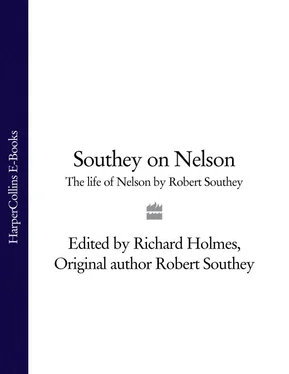The memory of Nelson compelled huge and lasting personal loyalty among all seamen, and tales of his exploits became legendary. For many men, contact with Nelson became in retrospect the defining moment of their lives. In a tiny Kentish churchyard, on the banks of the River Rother (which flows into the Thames estuary), I once stumbled upon a tombstone whose inscription read simply: “William Burke, Purser aboard his Majesty’s ship Victory, and in whose arms the immortal Nelson died.’
The witnesses of Nelson’s death are well-known to have been Dr Beatty, his surgeon, Dr Scott his chaplain, and Thomas Hardy, his ship’s captain. Yet the small, balding middle-aged William Burke did in fact support Nelson’s head during the three agonising hours it took him to die, kneeling down between him and the bulkhead, holding his shoulders in the dark, barely speaking a word. William Burke chose to record this moment in a perfect, but surely unconscious, iambic pentameter. The memory of Nelson had inspired the retired naval purser with a another fragment of English poetry, as a noble as an unwritten line from Shakespeare’s Henry V. ‘And in his arms the immortal Nelson died.’
Yet many of those contemporaries who knew Nelson best recognised profound contradictions in his character. When Wellington first met him, he thought Nelson ‘a charlatan’. Lord Minto described him as ‘a great man who was in some respects a baby’. His old commander in Chief Sir John Jervis, later Lord St Vincent, one of the greatest naval leaders of his day, gave it as his deliberate opinion, nine years after Nelson’s death, that: ‘Animal courage was the sole merit of Lord Nelson, his private character most disgraceful in every sense of the word.’
Many of his superior officers thought he was arrogant and absurdly flamboyant. His high-handed actions as a young officer in the West Indies led him to be pursued for years for £20,000’s worth of civil damages. Sir Hyde Parker, whose signal to withdraw he famously ignored at Copenhagen in 1801, always considered him dangerously impetuous in action and a grave diplomatic liability. Lord Keith was regularly infuriated by his refractory attitude to strategic commands in the Mediterranean.
He was frequently accused of vanity and self-importance. His separation from his wife, Frances Nisbet, in 1800 was thought shameful by many, including most of his relatives. His increasingly public liaison with the young and extravagant Lady Emma Hamilton, was considered scandalous, then vulgar, and finally humiliating. His stepson, Josiah Nisbet, came to hate him and frequently expressed the hope that with his one eye and one arm Nelson might one day conveniently fall over the side of his flag ship. His old friend and one time subordinate, Sir Thomas Troubridge, viewing things from the cool high chambers of the Admiralty, thought that popular fame (and Emma Hamilton) had gone to his head, and to other parts of his body too. Many, like Gillray and Cruikshank, thought that there was something irresistibly ludicrous about the small strutting figure, weighed down by his huge medals and his plump mistress.
Perhaps most damagingly, while on the Mediterranean station between June, 1799 and July, 1800, it was said that Nelson had become too personally involved with defending the corrupt Sicilian government at Naples, where Sir William Hamilton was Ambassador to the royal court. Here Nelson was thought to have been drawn (or perhaps seduced) into the gravest acts of political double-dealing and injustice. He was accused of disobeying orders to withdraw from Naples by Admiral Keith, of reneging on a truce signed by one of his own officers, Captain Foote, and conniving at the unjust court martial and execution of a Neapolitan patriot and naval officer Commodore Caracciolo. Worst of all, he was accused of allowing more than ninety civilian prisoners, including many women, who were officially under his protection in evacuation ships, to be returned to shore and executed in the cruellest manner by the Neapolitan authorities. Indeed some accused Nelson of war crimes in the Mediterranean.
In this glaring combination of light and shade, Nelson’s meteoric career and extraordinary seductive character offered all the moral contradictions of a peculiarly Romantic hero. But the triumph and tragedy of Trafalgar in October, 1805 meant that initially his whole reputation took on the aspect of a simple martyrdom. It was produced a period of unrestrained national mourning; a state funereal at St Paul’s attended by thirty-six admirals; and a great outpouring of Nelson tributes, reminiscences, and memorabilia.
Yet even in death Nelson provoked extreme reactions. Benjamin West, the President of the Royal Academy, painted a huge mythological tribute, with a mournful shadowy Neptune handing up the shrouded and distinctly Christ-like figure of Nelson (supported by an angel and surrounded by winged cherubs) into the arms of a resplendent and trident wielding Britannia. It was a deliberate and solemn apotheosis, perilously close to a religious Pieta.
In an altogether different spirit James Gillray executed a witty coloured cartoon, showing Nelson lying comfortably back upon the bosom of a buxom Britannia (Lady Hamilton of course, in an operatic flood of tears), while attended by a kneeling sea-captain (a grim George III) and a hysterical flag-waving midshipman (the Duke of Clarence). A sea-sprite circled overhead blowing Nelson’s own trumpet. It spouted a single word: not the expected ‘Victory’, but the self-vaunting ‘Immortality’.
In a newspaper article of 1811, discussing the new Romantic interest in celebrity and biography, Coleridge described these years of the English Regency as ‘emphatically, the Age of Personality’. So it was not surprising that a figure like Nelson, who seemed so much larger-than-life, was bound to exercise a fascination on people by the very vividness of his character as much as by the heroism of his actions. He had been asked to write his own autobiography as early as October, 1799, and did indeed dash off a Sketch of his life for John M’Arthur, a naval journalist working as joint-editor of The Naval Chronicle.
The result was a curious mixture of modesty and melodrama. Nelson mentions in passing the loss of eye and arm, his childless marriage, his failure to achieve spectacular prize-money (from captured ships), and his strictly local success in ‘placing the King of Naples back on his throne’. But his conclusion is like one of his battle signals hoist to the topgallant mast-head. ‘Without having any inheritance, or having been fortunate in prize money, I have received all the honours of my profession, been created a peer of Great Britain, and I may say to the reader: GO THOU AND DO LIKEWISE.’
After his death, a mass of brief memoirs were hastily published, especially dealing with disputed events at the battles of Aboukir Bay and Copenhagen, and the controversy over Nelson’s actions–and inactions–at Naples. Encouraged by Lady Hamilton, an inaccurate and highly partisan study was published by James Harrison in 1806. The following year 1807 William Beatty published his Authentic Narrative of the Death of Lord Nelson.
Then the journalist John M’Arthur joined forces with a navy chaplain and historian James Clarke, to produce a massive semiofficial assemblage of papers, The Life and Services of Horatio Viscount Nelson from his Lordships own Mss published in two enormous volumes in 1809. It drew widely on Nelson’s letters and despatches, and commissioned or republished eyewitness accounts. These volumes had the support of Lady Nelson, and were notable for the fact that they did not mention Lady Hamilton at all. They also carried, as their frontispiece to set the tone, an engraving of Benjamin West’s heroic painting.
Читать дальше












